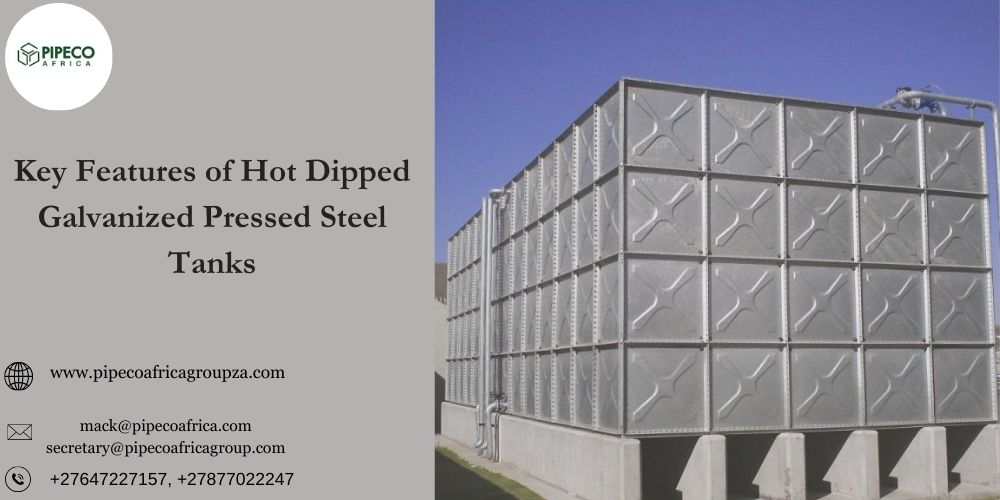Hot-dipped galvanized pressed steel tanks: advantages. For a range of sectors, HDG steel water tank in South Africa are a great option for liquid storage solutions. These square steel tanks are unique from other varieties available on the market because of their many advantages.
Hot-dipped Galvanized pressed steel tanks have the advantage of durability. Steel is protected from rust and corrosion by a layer of zinc applied during the hot dip galvanizing process. An uncoated tank will need far less care during its lifetime than a hot-dipped galvanized square pressed steel tank, which also has a far longer lifespan. By making the investment in a HDG Steel Water Tanks manufacturers, you can be confident that your storage solution will withstand the test of time and survive for up to 35–45 years.
Advantages of Pressed Steel Tanks With hot-dip Galvanization
Because they resist corrosion, hot-dipped galvanized pressed steel tanks are advantageous. By applying a layer of zinc to the steel, the galvanization process shields it from rust and other types of corrosion. Furthermore, hot-dipped galvanized tanks are inexpensive alternatives for liquid storage due to their strength and longevity. Additionally, they are simple to fix and maintain.
Hot dipped galvanized pressed square steel tanks also have the advantage of being very adaptable. They can be employed in many different ways, such as the storage of chemicals, fuel, and water. This makes them perfect for many different industries, including manufacturing, oil and gas, and agriculture. A hot-dipped galvanized pressed steel tank is suitable for hazardous material storage as well as the storage of potable water. The ability of these square tanks to be custom-configured to any length, breadth, or height in accordance with the customer’s available space is a key component of their versatility. Enabling customized solutions for every sector and use case.
HDG Steel Water Tanks manufacturers providing services are likewise incredibly affordable. They offer many of the same advantages as stainless-steel tanks, for instance, but at a lower cost. This makes them a great option for companies and institutions that need to maintain high performance and quality requirements at a reasonable cost.
Hot-dip Galvanizing is one of the best available techniques for protecting against corrosion. Enclosing the steel, the zinc coating acts as a barrier between the steel, the contents within the tank, and the outside world. Particularly in humid climates or areas close to the ocean, where there is a lot of moisture, this barrier protection is crucial. As an extra layer of defense for the steel, the zinc offers cathodic protection, which means that if the coating is compromised and the steel is left exposed, the zinc will corrode before the steel does.
Finally, environmentally friendly pressed steel tanks with hot dip galvanization. Natural, non-toxic, and non-polluting zinc is utilized in the galvanizing process. During the production process, it emits no hazardous gases into the atmosphere. You may store your liquid materials safely, securely, and with the least amount of environmental impact by selecting a hot dipped galvanized pressed steel tank.
The longer lifespan and lower maintenance and repair expenses of stainless steel tanks result in a lower total cost of ownership, even when tanks made of other materials could initially cost less. Additionally, because of steel’s strength, tank walls can have a thinner gauge. Transport and construction expenses are reduced with lighter, thinner panels. Stainless steel does not require internal or external protective coatings, therefore there is no need to worry about scratches during installation, aging or deteriorating coatings, or peeling external paint.
Stainless steel is the most hygienic material available for food processing, medicinal applications, and water containment, making stainless steel tanks the most hygienic choice for storing drinking water for communities.
While initially less expensive than stainless steel, plastic storage tanks are prone to mold and bacteria growth, and neither are expensive concrete storage tanks that can contaminate water supplies by leaching calcium.
There are several materials that can be used for water storage tanks, such as concrete, metal, and plastic. Each material has pros and cons. Because of their longevity, ease of maintenance, and environmental friendliness, industry experts believe that stainless steel tanks are the best option overall.
Conventionally produced carbon steels corrode in the presence of substances such as chlorides, moisture, and pH levels that are too high or too low. Structural breakdowns and safety risks may arise from the corrosion of carbon steel used in building construction. However, when alloyed with additional metals like chromium, stainless steel is resistant to corrosion from water and impurities and maintains its integrity in harsh weather conditions.
Also, Read – Decoding “Iganony”: Unveiling the Meaning and Mystery

